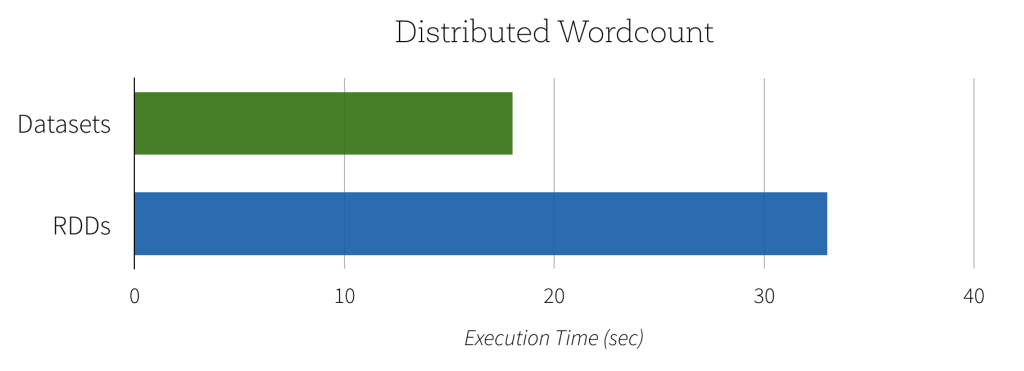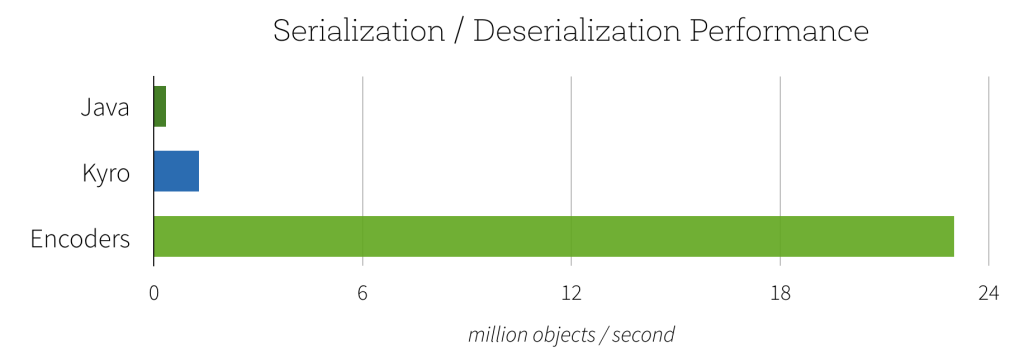Introducing Apache Spark Datasets(中英双语)
文章标题
Introducing Apache Spark Datasets
作者介绍
Michael Armbrust, Wenchen Fan, Reynold Xin and Matei Zaharia
文章正文
Developers have always loved Apache Spark for providing APIs that are simple yet powerful, a combination of traits that makes complex analysis possible with minimal programmer effort. At Databricks, we have continued to push Spark’s usability and performance envelope through the introduction of DataFrames and Spark SQL. These are high-level APIs for working with structured data (e.g. database tables, JSON files), which let Spark automatically optimize both storage and computation. Behind these APIs, the Catalyst optimizer and Tungsten execution engine optimize applications in ways that were not possible with Spark’s object-oriented (RDD) API, such as operating on data in a raw binary form.
Today we’re excited to announce Spark Datasets, an extension of the DataFrame API that provides a type-safe, object-oriented programming interface. Spark 1.6 includes an API preview of Datasets, and they will be a development focus for the next several versions of Spark. Like DataFrames, Datasets take advantage of Spark’s Catalyst optimizer by exposing expressions and data fields to a query planner. Datasets also leverage Tungsten’s fast in-memory encoding. Datasets extend these benefits with compile-time type safety – meaning production applications can be checked for errors before they are run. They also allow direct operations over user-defined classes.
In the long run, we expect Datasets to become a powerful way to write more efficient Spark applications. We have designed them to work alongside the existing RDD API, but improve efficiency when data can be represented in a structured form. Spark 1.6 offers the first glimpse at Datasets, and we expect to improve them in future releases.
1、Working with Datasets
A Dataset is a strongly-typed, immutable collection of objects that are mapped to a relational schema. At the core of the Dataset API is a new concept called an encoder, which is responsible for converting between JVM objects and tabular representation. The tabular representation is stored using Spark’s internal Tungsten binary format, allowing for operations on serialized data and improved memory utilization. Spark 1.6 comes with support for automatically generating encoders for a wide variety of types, including primitive types (e.g. String, Integer, Long), Scala case classes, and Java Beans.
Users of RDDs will find the Dataset API quite familiar, as it provides many of the same functional transformations (e.g. map, flatMap, filter). Consider the following code, which reads lines of a text file and splits them into words:
// RDDs
val lines = sc.textFile("/wikipedia")
val words = lines
.flatMap(_.split(" "))
.filter(_ != "")
// Datasets
val lines = sqlContext.read.text("/wikipedia").as[String]
val words = lines
.flatMap(_.split(" "))
.filter(_ != "")
Both APIs make it easy to express the transformation using lambda functions. The compiler and your IDE understand the types being used, and can provide helpful tips and error messages while you construct your data pipeline.
While this high-level code may look similar syntactically, with Datasets you also have access to all the power of a full relational execution engine. For example, if you now want to perform an aggregation (such as counting the number of occurrences of each word), that operation can be expressed simply and efficiently as follows:
// RDDs val counts = words
.groupBy(_.toLowerCase)
.map(w => (w._1, w._2.size))
// Datasets val counts = words
.groupBy(_.toLowerCase)
.count()
Since the Dataset version of word count can take advantage of the built-in aggregate count, this computation can not only be expressed with less code, but it will also execute significantly faster. As you can see in the graph below, the Dataset implementation runs much faster than the naive RDD implementation. In contrast, getting the same performance using RDDs would require users to manually consider how to express the computation in a way that parallelizes optimally.

Another benefit of this new Dataset API is the reduction in memory usage. Since Spark understands the structure of data in Datasets, it can create a more optimal layout in memory when caching Datasets. In the following example, we compare caching several million strings in memory using Datasets as opposed to RDDs. In both cases, caching data can lead to significant performance improvements for subsequent queries. However, since Dataset encoders provide more information to Spark about the data being stored, the cached representation can be optimized to use 4.5x less space.

To help you get started, we’ve put together some example notebooks: Working with Classes, Word Count.
2、Lightning-fast Serialization with Encoders
Encoders are highly optimized and use runtime code generation to build custom bytecode for serialization and deserialization. As a result, they can operate significantly faster than Java or Kryo serialization.

In addition to speed, the resulting serialized size of encoded data can also be significantly smaller (up to 2x), reducing the cost of network transfers. Furthermore, the serialized data is already in the Tungsten binary format, which means that many operations can be done in-place, without needing to materialize an object at all. Spark has built-in support for automatically generating encoders for primitive types (e.g. String, Integer, Long), Scala case classes, and Java Beans. We plan to open up this functionality and allow efficient serialization of custom types in a future release.
3、Seamless Support for Semi-Structured Data
The power of encoders goes beyond performance. They also serve as a powerful bridge between semi-structured formats (e.g. JSON) and type-safe languages like Java and Scala.
For example, consider the following dataset about universities:
{"name": "UC Berkeley", "yearFounded": 1868, numStudents: 37581}
{"name": "MIT", "yearFounded": 1860, numStudents: 11318}
…
Instead of manually extracting fields and casting them to the desired type, you can simply define a class with the expected structure and map the input data to it. Columns are automatically lined up by name, and the types are preserved.
case class University(name: String, numStudents: Long, yearFounded: Long)
val schools = sqlContext.read.json("/schools.json").as[University]
schools.map(s => s"${s.name} is ${2015 – s.yearFounded} years old")
Encoders eagerly check that your data matches the expected schema, providing helpful error messages before you attempt to incorrectly process TBs of data. For example, if we try to use a datatype that is too small, such that conversion to an object would result in truncation (i.e. numStudents is larger than a byte, which holds a maximum value of 255) the Analyzer will emit an AnalysisException.
case class University(numStudents: Byte)
val schools = sqlContext.read.json("/schools.json").as[University]
org.apache.spark.sql.AnalysisException: Cannot upcast `yearFounded` from bigint to smallint as it may truncate
When performing the mapping, encoders will automatically handle complex types, including nested classes, arrays, and maps.
4、A Single API for Java and Scala
Another goal to the Dataset API is to provide a single interface that is usable in both Scala and Java. This unification is great news for Java users as it ensure that their APIs won’t lag behind the Scala interfaces, code examples can easily be used from either language, and libraries no longer have to deal with two slightly different types of input. The only difference for Java users is they need to specify the encoder to use since the compiler does not provide type information. For example, if wanted to process json data using Java you could do it as follows:
public class University implements Serializable {
private String name;
private long numStudents;
private long yearFounded;
public void setName(String name) {...}
public String getName() {...}
public void setNumStudents(long numStudents) {...}
public long getNumStudents() {...}
public void setYearFounded(long yearFounded) {...}
public long getYearFounded() {...}
}
class BuildString implements MapFunction {
public String call(University u) throws Exception {
return u.getName() + " is " + (2015 - u.getYearFounded()) + " years old.";
}
}
Dataset schools = context.read().json("/schools.json").as(Encoders.bean(University.class));
Dataset strings = schools.map(new BuildString(), Encoders.STRING());
5、Looking Forward
While Datasets are a new API, we have made them interoperate easily with RDDs and existing Spark programs. Simply calling the rdd() method on a Dataset will give an RDD. In the long run, we hope that Datasets can become a common way to work with structured data, and we may converge the APIs even further.
As we look forward to Spark 2.0, we plan some exciting improvements to Datasets, specifically:
- Performance optimizations – In many cases, the current implementation of the Dataset API does not yet leverage the additional information it has and can be slower than RDDs. Over the next several releases, we will be working on improving the performance of this new API.
- Custom encoders – while we currently autogenerate encoders for a wide variety of types, we’d like to open up an API for custom objects.
- Python Support.
- Unification of DataFrames with Datasets – due to compatibility guarantees, DataFrames and Datasets currently cannot share a common parent class. With Spark 2.0, we will be able to unify these abstractions with minor changes to the API, making it easy to build libraries that work with both.
If you’d like to try out Datasets yourself, they are already available in Databricks. We’ve put together a few example notebooks for you to try out: Working with Classes, Word Count.
Spark 1.6 is available on Databricks today, sign up for a free 14-day trial.
参考文献
- https://databricks.com/blog/2016/01/04/introducing-apache-spark-datasets.html
- https://blog.csdn.net/sunbow0/article/details/50723233
Introducing Apache Spark Datasets(中英双语)的更多相关文章
- 我在 B 站学机器学习(Machine Learning)- 吴恩达(Andrew Ng)【中英双语】
我在 B 站学机器学习(Machine Learning)- 吴恩达(Andrew Ng)[中英双语] 视频地址:https://www.bilibili.com/video/av9912938/ t ...
- Introducing DataFrames in Apache Spark for Large Scale Data Science(中英双语)
文章标题 Introducing DataFrames in Apache Spark for Large Scale Data Science 一个用于大规模数据科学的API——DataFrame ...
- A Tale of Three Apache Spark APIs: RDDs, DataFrames, and Datasets(中英双语)
文章标题 A Tale of Three Apache Spark APIs: RDDs, DataFrames, and Datasets 且谈Apache Spark的API三剑客:RDD.Dat ...
- What’s new for Spark SQL in Apache Spark 1.3(中英双语)
文章标题 What’s new for Spark SQL in Apache Spark 1.3 作者介绍 Michael Armbrust 文章正文 The Apache Spark 1.3 re ...
- Apache Spark as a Compiler: Joining a Billion Rows per Second on a Laptop(中英双语)
文章标题 Apache Spark as a Compiler: Joining a Billion Rows per Second on a Laptop Deep dive into the ne ...
- One SQL to Rule Them All – an Efficient and Syntactically Idiomatic Approach to Management of Streams and Tables(中英双语)
文章标题 One SQL to Rule Them All – an Efficient and Syntactically Idiomatic Approach to Management of S ...
- Matalb中英双语手册-年少无知翻译版本
更新: 20171207: 这是大学期间参加数模翻译的手册 正文: 愚人节快乐,突然发现自己在博客园的一篇文章.摘取如下: MATLAB 语言是一种工程语言,语法很像 VB 和 C,比 R 语言容易学 ...
- Spark 论文篇-RDD:一种为内存化集群计算设计的容错抽象(中英双语)
论文内容: 待整理 参考文献: Resilient Distributed Datasets: A Fault-Tolerant Abstraction for In-Memory Cluster C ...
- Deep Dive into Spark SQL’s Catalyst Optimizer(中英双语)
文章标题 Deep Dive into Spark SQL’s Catalyst Optimizer 作者介绍 Michael Armbrust, Yin Huai, Cheng Liang, Rey ...
随机推荐
- Django分页(二)
Django分页(二) 要求 .设定每页显示数据条数 # # .用户输入页码(第一页.第二页...) # # .设定显示多少页号 # # .获取当前数据总条数 # # .根据设定显示多少页号和数据总条 ...
- HTML文本结构及常用标签
一.什么是HTML? HTML:超文本标签语言 (Hyper Text Markup Language) www万维网的描述性语言. XHTML指可扩展超文本标记语言(标识语言)(EXtensible ...
- 可编辑DIV与移动端软键盘兼容性问题汇总
此文复现的所有兼容性问题均为以下情况: 1. 腾讯X5内核 2. 全屏webview 问题如下: 1. IOS12 中软键盘弹出导致页面顶部截断,并且无法恢复. 解决方法:添加交互事件,调用本地方法, ...
- 洛谷 P1078 文化之旅(CODEVS 1316)
题目描述 有一位使者要游历各国,他每到一个国家,都能学到一种文化,但他不愿意学习任何一 种文化超过一次(即如果他学习了某种文化,则他就不能到达其他有这种文化的国家).不 同的国家可能有相同的文化.不同 ...
- UOJ.35.[模板]后缀排序(后缀数组 倍增)
题目链接 论找到一个好的教程的正确性.. 后缀数组 下标从1编号: //299ms 2560kb #include <cstdio> #include <cstring> #i ...
- jquery 1.7.2源码解析(二)构造jquery对象
构造jquery对象 jQuery对象是一个类数组对象. 一)构造函数jQuery() 构造函数的7种用法: 1.jQuery(selector [, context ]) 传入字符串参数:检查该字符 ...
- 01 bubbleSort
#include<cstdio> #include <memory> #include <iostream> using namespace std; void b ...
- windows安装channels报错的解决方案
windows作为开发机真是让人又爱又恨,总是会遇到各种各样的问题 报错 以安装channels为例:如: pip install channels 时出现: error: Microsoft V ...
- [CC-MCO16306]Fluffy and Alternating Subsequence
[CC-MCO16306]Fluffy and Alternating Subsequence 题目大意: 给定一个\(1\sim n(n\le3\times10^5)\)的排列\(a\). 对于一个 ...
- [AHOI2009]维护序列
OJ题号:洛谷2023.BZOJ1798 思路: 参见[洛谷3373][模板]线段树 2 #include<cstdio> #include<cctype> #include& ...
